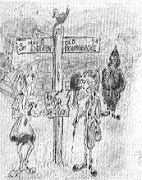'Sonnet-writing for dummies' says that a sonnet is a lyric poem of 14 lines, each a iambic pentameter.
In the Shakepearean form (also Spenserian), the poem contains 3 quatrains and a final couplet. The rhyme scheme is abab, cdcd, efef, gg.
As a rule the quatrains deal in turn with an opening idea or idea, followed by a development, then a shift, with the couplet summing up or providing a punch-line or a surprise. My theme - that days and women are both precious, but that both desert you, fits neatly into this scheme.
Namely: morning, afternoon, evening. And I've got surprise of sorts. So far, so good.
A few things to remember:
- I mustn't let the iambic pentameter become boring. 14 lines of dee-dum, dee-dum, dee-dum will not do. Shakespeare would often start a line with the emphasis on the first syllable of the line. For example, 'Now is / the win / ter of . . .' And, 'Shall I compare thee . . .' where the first two syllables are pretty even in strength.
- Enjambement gives variety and force, as in: 'Like to the lark at break of day arising / From sullen earth sings hymns at heaven's gate.'
- In this day and age poetic ellisions like 'ope' and 'oe'r' are inappropriate, although the iambic pentameter cries out for them. 'Open' and 'over' waste syllables.
- Beware 'poetic' cliches, such as abstract nouns, too many adverbs, putting the adjective after the noun, etc.
- On the other hand, don't be afraid of long words, if they are natural to me.
- Don't let the need for rhyme dictate the content. Substitute with assonance and para-rhyme if you like.
Now I'd better get on with it.
Remember that all glory is fleeting, but obscurity is forever.
Napoleon Bonaparte

No comments:
Post a Comment